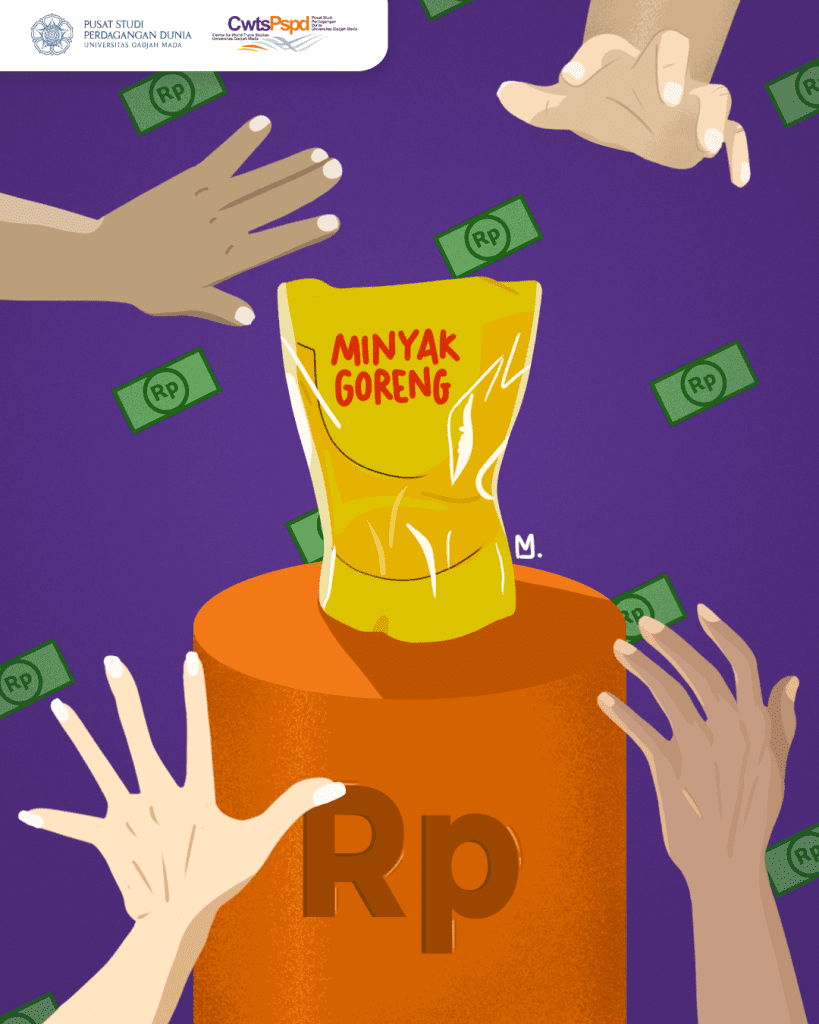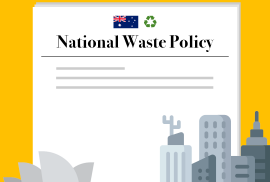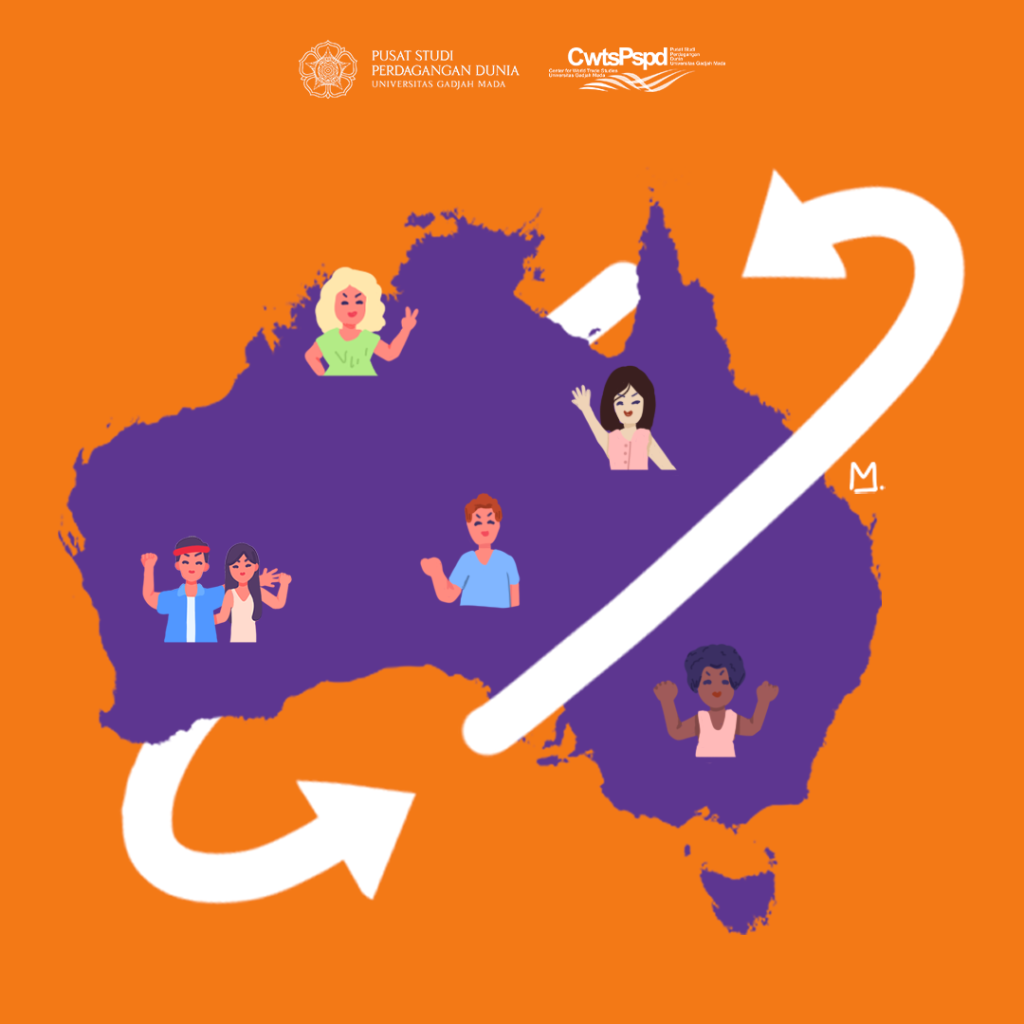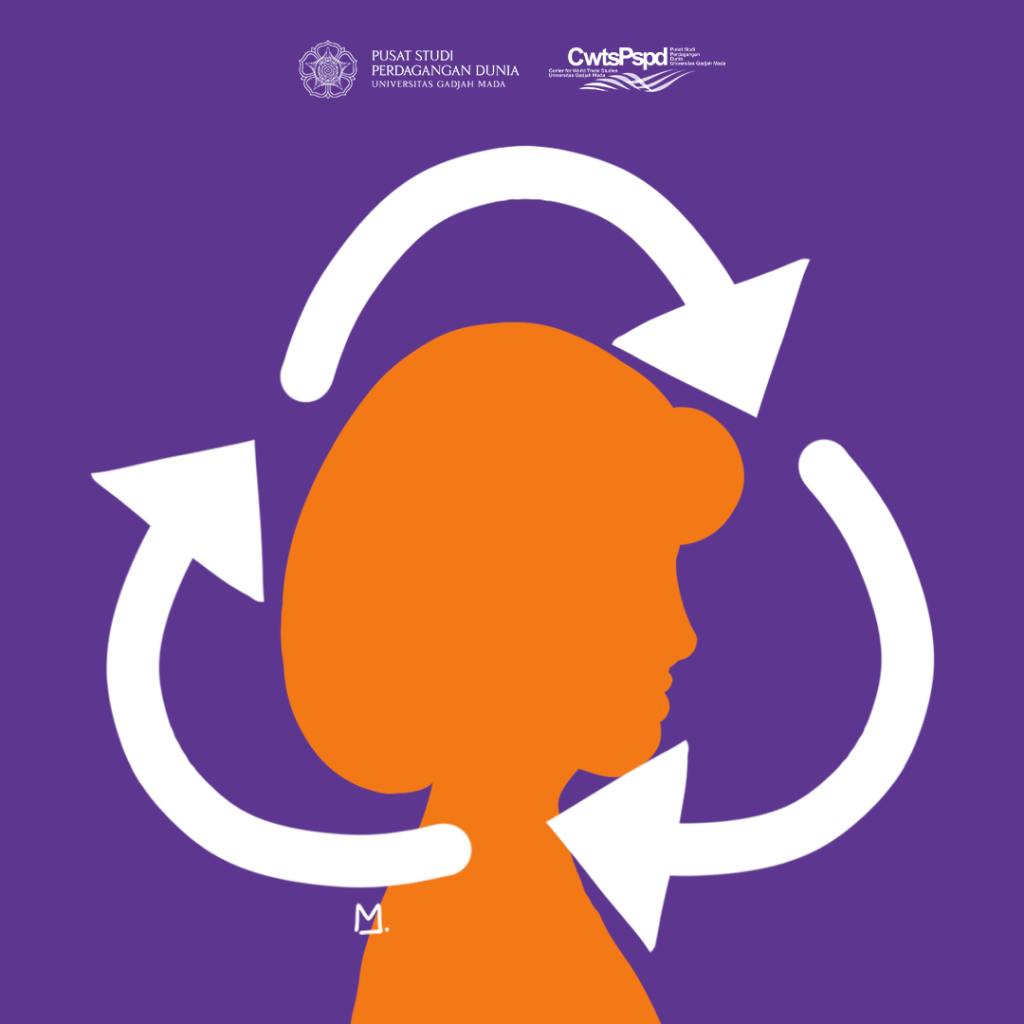Minyak Goreng Langka? Ternyata Inilah Penyebabnya!
Op-Ed In Sabtu, 5 Maret 2022

Penulis:
Raevita Andriessa
SEO Content Writer, Pusat Studi Perdagangan Dunia Universitas Gadjah Mada.

Editor:
Nabila Asysyfa Nur
Website Content Manager, Pusat Studi Perdagangan Dunia Universitas Gadjah Mada.

Ilustrasi:
Marsha
Desainer Grafis, Pusat Studi Perdagangan Dunia Universitas Gadjah Mada.
Terhitung sejak awal Oktober 2021 lalu, harga minyak goreng di Indonesia naik secara signifikan. Berdasarkan data dari Pusat Informasi Harga Pangan Strategis Nasional dalam Katadata.id, harga minyak goreng pada pada 7 Oktober 2021 telah mencapai Rp15.550,- per kilogram. Mirisnya lagi, harga minyak goreng di awal Januari 2022 semakin melambung tinggi mencapai angka Rp18.550,- per kilogram nya. Harga minyak goreng kemasan bermerek pun tak mau kalah dan mencetak harga yang lebih tinggi lagi yakni seharga Rp21.150,- per kilogram.
Tingginya permintaan dan turunnya penawaran minyak goreng mengakibatkan kelangkaan dan kenaikan harga minyak goreng di sebagian besar daerah di Indonesia. Sementara itu, minyak goreng merupakan salah satu komoditas yang paling dibutuhkan oleh masyarakat setiap harinya untuk mencukupi kebutuhan pangan. Oleh sebab itu, kelangkaan minyak goreng sangat meresahkan masyarakat Indonesia terutama untuk masyarakat dari kelas menengah ke bawah. Masyarakat mulai bertanya-tanya mengenai penyebab kenaikan harga dan kelangkaan minyak goreng di pasaran? Kira-kira apa saja yang menjadi faktor-faktor penyebabnya? Simak bahasannya di sini!
1. Kenaikan Harga Minyak Nabati Dunia
Rupanya, kenaikan harga minyak goreng nabati tak hanya terjadi di Indonesia tetapi terjadi juga di seluruh dunia. Saat ini, harga Crude Palm Oil (CPO) atau minyak nabati mentah telah melonjak menjadi US$ 1.340/mT atau setara dengan Rp19.291.243,-. Terjadinya kenaikan harga minyak mentah dalam skala global sangat berpengaruh terhadap kenaikan harga minyak nabati mentah termasuk minyak goreng di pasaran.
Dilansir dari CNBC Indonesia, Direktur Eksekutif Gabungan Industri Minyak Nabati Indonesia (GIMNI), Sahat Sinaga, membeberkan alasan mengapa harga minyak mentah di dunia melonjak tinggi. Beliau mengatakan bahwa permintaan minyak nabati semakin meningkat setelah kebijakan-kebijakan yang berkaitan dengan protokol kesehatan COVID-19 mulai longgar. Tetapi di sisi lain, produksi minyak nabati dunia anjlok 3,5% di tahun 2021 dan menyebabkan terganggunya suplai minyak mentah untuk olahan minyak lainnya.
2. Penerapan Kebijakan B30
Sejak kuartal pertama tahun 2020 silam, pemerintah telah menerapkan kebijakan B30. Kebijakan ini mewajibkan para perusahaan bahan bakar minyak di Indonesia untuk mencampur bahan bakar minyak jenis solar sebanyak 70% dengan biodiesel sebanyak 30%. Tujuan dari diadakannya kebijakan ini adalah untuk menghemat bahan bakar fosil yang serba terbatas dengan cara mencampur bahan bakar lain dalam proses pengolahan bahan bakar minyak. Kebijakan mencampurkan BBM jenis solar dengan biodiesel telah dilakukan oleh banyak negara lainnya, akan tetapi dengan kadar biodiesel dibawah 30% yakni tidak setinggi kebijakan B30 yang diterapkan oleh Indonesia.
Awalnya, pemerintah meluncurkan kebijakan B30 untuk mengurangi laju impor BBM sehingga meningkatkan devisa negara. Namun, kebijakan ini berdampak pada bertambahnya permintaan CPO di Indonesia yang kemudian turut berkontribusi sebagai penyebab kelangkaan bahan baku minyak goreng di Indonesia. Untuk menahan laju harga minyak goreng di pasaran, GIMNI mencoba untuk melakukan lobi pada pemerintah agar meringankan kebijakan B30 menjadi B20. Melalui usulan tersebut, harapannya kebijakan B20 dapat menekan jumlah permintaan minyak nabati mentah yang terus meningkat untuk mengurangi angka konsumsi hingga 3 juta ton yang dapat mencukupi jumlah kebutuhan minyak goreng di dalam negeri.
3. Terganggunya Arus Logistik
Selain dari angka produksi minyak nabati mentah yang anjlok, arus logistik yang berperan dalam distribusi minyak nabati mentah pun ikut macet. Penyebabnya tak lain adalah pandemi COVID-19 yang masih belum kunjung teratasi. Banyak pekerja kasar pada sektor logistik terkena PHK karena dampak dari pandemi COVID-19 yang menyerang stabilitas perusahaan-perusahaan logistik. Selain itu, kondisi finansial perusahaan logistik yang tak kunjung membaik juga berdampak langsung pada jumlah unit transportasi yang mereka miliki untuk kegiatan distribusi bahan baku.
Macetnya arus logistik selama pandemi COVID-19 mengakibatkan biaya yang harus produsen keluarkan semakin banyak termasuk biaya ekspedisi. Ditambah lagi, biaya ekstra yang dikeluarkan untuk ekspedisi tidak dapat membuat produk mereka sampai dengan segera ke tangan konsumen karena faktor kurangnya tenaga kerja. Alhasil, minyak goreng menjadi semakin langka dan mahal di pasaran.
Terjadinya kelangkaan minyak goreng karena beberapa faktor diatas lantas mendorong pemerintah untuk memberlakukan kebijakan baru. Per tanggal 19 Januari 2022, Kementerian Perdagangan Indonesia telah menetapkan kebijakan yang mewajibkan perusahaan ritel dan pedagang sembako untuk menjual minyak goreng dengan Harga Eceran Tertinggi (HET) sebesar Rp.14.000,-. per liter. Pembelian minyak goreng dengan harga spesial ini dibarengi dengan ketentuan lainnya, yakni setiap orang hanya dapat membeli minyak goreng kemasan satu liter sebanyak dua bungkus dengan total sebanyak dua liter per orang. Tetapi apakah kebijakan ini ampuh untuk mengatasi kelangkaan minyak goreng serta kenaikan harganya?
Kebijakan pemerintah untuk menetapkan harga yang sama untuk penjualan minyak goreng dan membatasi pembeliannya dapat menjadi sebuah pedang bermata dua karena implementasinya yang justru dapat memperparah kelangkaan minyak goreng di tengah masyarakat. Di satu sisi, kebijakan tersebut dapat mengundang masyarakat untuk menjadi penimbun dengan berbagai strategi. Salah satu strategi yang paling umum adalah dengan memanfaatkan anggota keluarga yang berada di satu tempat tinggal yang sama untuk membeli minyak goreng ke tempat yang berbeda-beda dan menimbunnya di rumah. Katakan satu pasang suami istri memiliki dua anak di rumahnya, berarti saat setiap orang membeli dua liter minyak, maka di rumah mereka akan terkumpul hingga delapan liter minyak. Bayangkan jika banyak oknum lain melakukan hal yang sama pada waktu yang bersamaan, hal ini tentu akan berakibat pada minyak goreng yang semakin langka.
Menimbang hal tersebut, formulasi kebijakan yang lebih efektif sangat diperlukan untuk mengatasi masalah kelangkaan minyak goreng di Indonesia saat ini. Minyak goreng merupakan salah satu bahan pangan pokok yang masyarakat butuhkan sehari-hari dan kelangkaan komoditas tersebut akan berdampak pada tidak tercukupinya kebutuhan pangan dan industri masyarakat. Masyarakat juga harus turut kooperatif dalam melaksanakan kebijakan pemerintah dan diharapkan dapat menakar kebutuhan masing-masing demi kepentingan bersama. Edukasi terhadap diri sendiri sangatlah penting untuk menambah kepekaan terhadap kondisi perekonomian di dunia.









